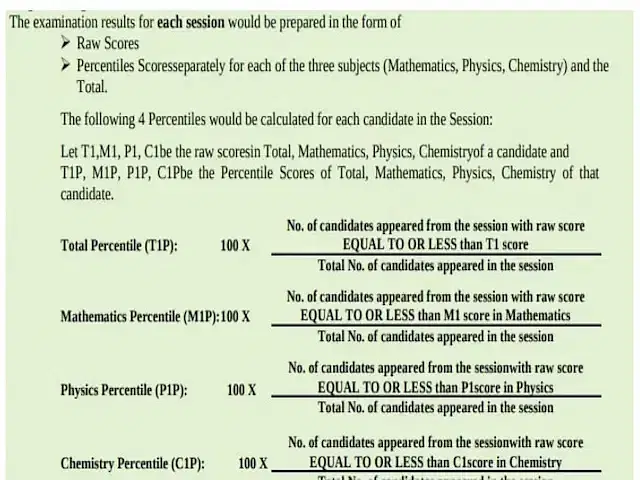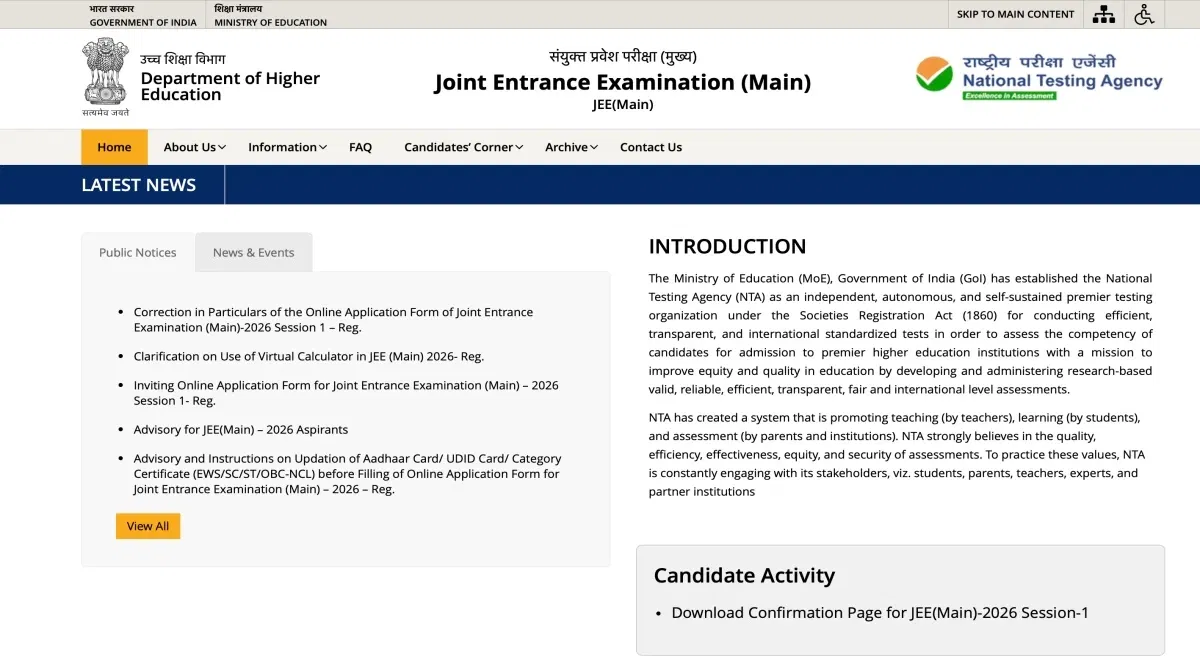What is the NTA Score in JEE Main Results 2026? It is an aggregate percentile score of all three subjects across multi-session papers of JEE Main. It is calculated to ensure that all candidates have equal scores regardless of the difficulty level of JEE Main papers.
Table of Contents
What is NTA Score in JEE Main Result 2026? NTA Score stands for the standardized score that is used to evaluate the relative performance of the test takers across all three subjects and the sessions of the JEE Main paper. It is calculated to ease the marking system based on a normalised score, regardless of the difficulty level of the exam.
The authorities consider factors such as the difficulty of the exam, the number of candidates taking it, and the distribution of marks among those candidates when calculating the NTA score in the JEE Main result.
Students willing to appear for the JEE Main 2026 must check how their marks are normalised and calculated as percentile scores. This way they will be able to anticipate their chances of qualifying for the exam.
What is the NTA Score in JEE Main?
NTA score is a positional rank or percentile score of a candidate who appeared for the JEE Main exam. The score calculation is based on the relative performance of candidates who have appeared across the different shifts of the exam.
The raw marks obtained from the session-wise test are normalized. The marks obtained are transferred into a 100-to-0 scale for each session. Then, your position on the scale is calculated by a simple percentile.
The normalized score is then calculated against the multi-session scores to get an NTA score.
For Example, Let us say that 100 candidates, including you, appeared for the JEE Main exam. On the day of the JEE Main result 2026, your percentile score is 99. This means that 98 candidates scored below you.
Also Read: How to Score 95+ Percentile in JEE Main 2026?
How to Check NTA Score?
The NTA scores are released along with the JEE Main results @jeemain.nta.nic.in. For session 1, the scores were released on Feb 11, 2026. To check the NTA scores, you must follow the steps:
- Step 1: Visit the official website of NTA at jeemain.nta.nic.in.
- Step 2: On the homepage, navigate to you activity section to access the JEE Main result link.
- Step 3: Click on the link saying, “JEE(Main) 2026 Session-1 Result.”
- Step 4: Enter the application number and password.
- Step 5: A new window will open containing the NTA scores in the form of your scorecards. Download it and save it for future reference.
How are NTA Scores Used?
The NTA scores are used to determine your probable ranks in the JEE Main 2026 exam. These are the primary criteria to select you for the next stages of the JEE exam.
If you have high NTA scores, you can appear for the JEE Advanced Exam 2026. They can also gain admission to the top-tier engineering colleges in India, including NITs, IIITs, GFTIs, and other popular institutes.
Also Read: Minimum Marks Required for 90 Percentile in JEE Main 2026
Difference Between NTA Score vs Marks vs Percentile
What are NTA scores, marks and percentile? Here's a quick overview:
- Raw Score or Raw Marks: The raw score/ mark is your score. Your raw score may vary a lot, but depending on the range your raw score falls under, you will get a particular NTA score and Percentile. Generally, the maximum raw score you can get is set to 300.
- NTA Score: The NTA score is the percentile score or position of the students who have shown up for the JEE exam. The NTA score is determined after applying the normalization process to your raw marks against multiple sessions. Estimates are derived from many understudies who showed up for the JEE Main assessment. More importantly, do not mistake NTA scores for crude scores!
- Percentile: The percentile score denotes the percentage of candidates that have scored equal to or below (same or lower score) the percentile in the exam. This score is based on your relative performance who have appeared for the exam. The percentile score is calculated by converting the total marks secured by you into a scale ranging from 100 to 0 for each examinee session.
JEE Main marks are your actual score acquired out of 300 marks. NTA scores are the aggregate marks after normalization based on difficulty level, number of test takers, and overall distribution of the marks.
The National Testing Agency (NTA) utilizes the percentile equivalence for the normalization process (formula) across subjects - Physics, Chemistry, and Maths (PCM), as well as the total.
How to Calculate the NTA Score in JEE Main Result?
The following are the steps involved in calculating the NTA score:
- First, your actual marks (raw marks) are combined by adding the individual marks for all three subjects.
- The JEE Main exam is conducted across multiple sessions, where the difficulty level of each shift or paper might vary. To ensure your fairness and equal opportunity, NTA employs a normalisation process where raw scores obtained by you in each session are transformed into a scale ranging from 100 to 0.
- Once the normalised score is obtained, the conducting body converts the raw score of each candidate into a percentile. It indicates the percentage of candidates who scored below or equal to the normalised score or a particular candidate in that session.
- The percentile scores can be calculated to 7 decimal places to avoid the bunching effect and reduce ties among participants with similar scores.
The formula for Percentile Score is as follows:

The total number of candidates who appeared in the "Session."
Note: The percentage of the total shall NOT be an aggregate or average of the percentage of the individual subject. The percentile Score is not similar to the Percentage of Marks achieved.
Also Read: How to Calculate JEE Main 2026 Rank From Percentile?
What is a Good NTA Score in JEE Main for IITs?
One of the most frequent questions asked is "What is a good NTA score in JEE Main for IIT or JEE Advanced?" 85 - 90 percentile is considered a good NTA score in JEE Main for IITs. It means that you must score 250 or above in JEE Main to gain admission to top IITs and NITs or appear for the JEE Advanced.
Here's a quick overview of the highest NTA score in JEE Main:
|
JEE Main Marks Out of 300 |
Remarks |
|
280+ |
Excellent |
|
265+ |
Very Good |
|
250+ |
Good |
|
225 or below |
Average |
|
200 or below |
Low |
Also Read: What is a Good Score in JEE Main 2026?
Expected NTA Score vs Percentile vs Rank in JEE Main 2026
Ranks are allotted based on the percentile achieved by you. Refer to the table below to know the expected ranking vs percentile vs score in JEE Main 2026:
|
JEE Main 2026 Marks out of 300 |
JEE Main Percentile Score |
JEE Main Rank (Expected) |
|
288 - 294 |
99.99826992- 99.99890732 |
20 - 11 |
|
280 - 284 |
99.99617561 - 99.99790569 |
44 - 22 |
|
270 - 279 |
99.99034797 - 99.99417236 |
107 - 63 |
|
252 - 268 |
99.95228621- 99.99016586 |
522 - 106 |
|
231 - 249 |
99.87388626-99.95028296 |
1385 - 546 |
|
215 - 230 |
99.74522293-99.87060821 |
2798 - 1421 |
|
202 - 214 |
99.57503767- 99.73930423 |
4666 - 2682 |
|
190 - 200 |
99.39319714- 99.56019541 |
6664 - 4830 |
|
175 - 189 |
99.02150308 - 99.3487614 |
10746 - 7151 |
|
161 - 174 |
98.52824811-98.99673561 |
16163 - 11018 |
|
149 - 159 |
98.07460288-98.49801724 |
21145 - 16495 |
|
132 - 148 |
97.0109678-97.97507774 |
32826 - 22238 |
|
120 - 131 |
96.0687115-96.93721175 |
43174 - 33636 |
|
110 - 119 |
95.05625037-95.983027 |
54293 - 44115 |
|
102 - 109 |
94.01228357-94.96737888 |
65758 - 55269 |
|
95 - 101 |
93.05600452 -93.89928202 |
76260 - 66999 |
|
89 - 94 |
92.05811248 -92.88745828 |
87219 - 78111 |
|
79 - 88 |
90.0448455 -91.79177119 |
109329 - 90144 |
|
64 - 87 |
84.56203931-91.59517945 |
169542 - 92303 |
|
44 - 62 |
70.26839007-84.22540213 |
326517 - 173239 |
|
1 - 42 |
66.6590786-69.5797271 |
1025009 - 334080 |
Read More: JEE Main Percentile vs Marks vs Rank 2026
NTA score in JEE Main 2026 is the aggregate, normalised score across all shifts of the exam. Your actual or raw score is converted into a percentile, which is the relative score. JEE Main 2026 merit list is prepared based on the normalised score.







![Indian Institute of Technology, [IIT] Kanpur](https://media.getmyuni.com/azure/college-image/small/indian-institute-of-technology-iit-kanpur.jpg)
![Indian Institute of Technology, [IIT] Roorkee](https://media.getmyuni.com/azure/college-image/small/indian-institute-of-technology-iit-roorkee.jpg)
![Jawaharlal Nehru University, [JNU] New Delhi](https://media.getmyuni.com/azure/college-image/small/jawaharlal-nehru-university-jnu-new-delhi.jpg)
![University of Calcutta, [UC] Kolkata](https://media.getmyuni.com/azure/college-image/small/university-of-calcutta-uc-kolkata.jpg)





























POST YOUR COMMENT